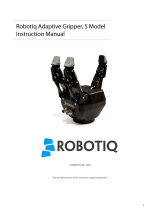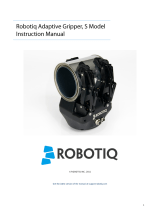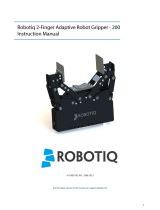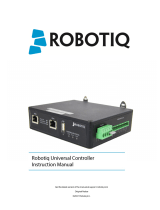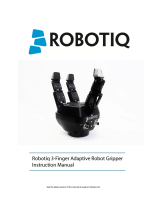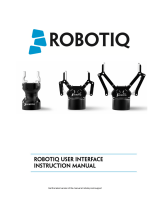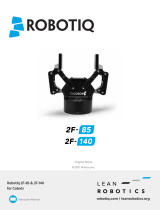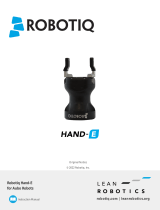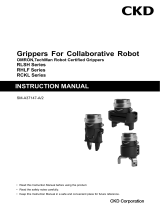Page is loading ...

Table of Contents
Robotiq inc. © 2013 2
Revisions . . . . . . . . . . . . . . . . . . . . . . . . . . . . . . . . . . . . . . . . . . . . . . . . . . . . . . . . . . . . . . . . . . . . . . . . . . . . . . . . . . . . . . . . . . . . . . . . . . . . 3
1. General Presentation . . . . . . . . . . . . . . . . . . . . . . . . . . . . . . . . . . . . . . . . . . . . . . . . . . . . . . . . . . . . . . . . . . . . . . . . . . . . . . . . . . . . . . . . . 3
2. Safety . . . . . . . . . . . . . . . . . . . . . . . . . . . . . . . . . . . . . . . . . . . . . . . . . . . . . . . . . . . . . . . . . . . . . . . . . . . . . . . . . . . . . . . . . . . . . . . . . . . . . 10
2.1 Warning . . . . . . . . . . . . . . . . . . . . . . . . . . . . . . . . . . . . . . . . . . . . . . . . . . . . . . . . . . . . . . . . . . . . . . . . . . . . . . . . . . . . . . . . . . . . . . . 10
2.2 Intended use . . . . . . . . . . . . . . . . . . . . . . . . . . . . . . . . . . . . . . . . . . . . . . . . . . . . . . . . . . . . . . . . . . . . . . . . . . . . . . . . . . . . . . . . . . . 10
3. Installation . . . . . . . . . . . . . . . . . . . . . . . . . . . . . . . . . . . . . . . . . . . . . . . . . . . . . . . . . . . . . . . . . . . . . . . . . . . . . . . . . . . . . . . . . . . . . . . . . 11
3.1 Environmental and operating conditions . . . . . . . . . . . . . . . . . . . . . . . . . . . . . . . . . . . . . . . . . . . . . . . . . . . . . . . . . . . . . . . . . . . . . . 11
3.2 Mechanical connections . . . . . . . . . . . . . . . . . . . . . . . . . . . . . . . . . . . . . . . . . . . . . . . . . . . . . . . . . . . . . . . . . . . . . . . . . . . . . . . . . . 12
3.3 Power supply specifications . . . . . . . . . . . . . . . . . . . . . . . . . . . . . . . . . . . . . . . . . . . . . . . . . . . . . . . . . . . . . . . . . . . . . . . . . . . . . . . 13
3.4 Wiring . . . . . . . . . . . . . . . . . . . . . . . . . . . . . . . . . . . . . . . . . . . . . . . . . . . . . . . . . . . . . . . . . . . . . . . . . . . . . . . . . . . . . . . . . . . . . . . . 14
3.4.1 Power connection . . . . . . . . . . . . . . . . . . . . . . . . . . . . . . . . . . . . . . . . . . . . . . . . . . . . . . . . . . . . . . . . . . . . . . . . . . . . . . . . . . 15
3.4.2 Communication connection . . . . . . . . . . . . . . . . . . . . . . . . . . . . . . . . . . . . . . . . . . . . . . . . . . . . . . . . . . . . . . . . . . . . . . . . . . . 17
DeviceNet communication protocol . . . . . . . . . . . . . . . . . . . . . . . . . . . . . . . . . . . . . . . . . . . . . . . . . . . . . . . . . . . . . . . . . . . . . . 18
CANopen communication protocol . . . . . . . . . . . . . . . . . . . . . . . . . . . . . . . . . . . . . . . . . . . . . . . . . . . . . . . . . . . . . . . . . . . . . . 20
Real-time Ethernet communication protocol . . . . . . . . . . . . . . . . . . . . . . . . . . . . . . . . . . . . . . . . . . . . . . . . . . . . . . . . . . . . . . . 22
Serial communication protocol . . . . . . . . . . . . . . . . . . . . . . . . . . . . . . . . . . . . . . . . . . . . . . . . . . . . . . . . . . . . . . . . . . . . . . . . . . 24
4. Control . . . . . . . . . . . . . . . . . . . . . . . . . . . . . . . . . . . . . . . . . . . . . . . . . . . . . . . . . . . . . . . . . . . . . . . . . . . . . . . . . . . . . . . . . . . . . . . . . . . . 25
4.1 Generalities . . . . . . . . . . . . . . . . . . . . . . . . . . . . . . . . . . . . . . . . . . . . . . . . . . . . . . . . . . . . . . . . . . . . . . . . . . . . . . . . . . . . . . . . . . . . 25
4.2 Status overview . . . . . . . . . . . . . . . . . . . . . . . . . . . . . . . . . . . . . . . . . . . . . . . . . . . . . . . . . . . . . . . . . . . . . . . . . . . . . . . . . . . . . . . . . 26
4.3 Control overview . . . . . . . . . . . . . . . . . . . . . . . . . . . . . . . . . . . . . . . . . . . . . . . . . . . . . . . . . . . . . . . . . . . . . . . . . . . . . . . . . . . . . . . . 27
4.4 Status LEDs . . . . . . . . . . . . . . . . . . . . . . . . . . . . . . . . . . . . . . . . . . . . . . . . . . . . . . . . . . . . . . . . . . . . . . . . . . . . . . . . . . . . . . . . . . . 28
4.4.1 Supply LED . . . . . . . . . . . . . . . . . . . . . . . . . . . . . . . . . . . . . . . . . . . . . . . . . . . . . . . . . . . . . . . . . . . . . . . . . . . . . . . . . . . . . . . 29
4.4.2 Communication LED . . . . . . . . . . . . . . . . . . . . . . . . . . . . . . . . . . . . . . . . . . . . . . . . . . . . . . . . . . . . . . . . . . . . . . . . . . . . . . . . 29
4.4.3 Fault LED . . . . . . . . . . . . . . . . . . . . . . . . . . . . . . . . . . . . . . . . . . . . . . . . . . . . . . . . . . . . . . . . . . . . . . . . . . . . . . . . . . . . . . . . . 29
4.5 Gripper register mapping . . . . . . . . . . . . . . . . . . . . . . . . . . . . . . . . . . . . . . . . . . . . . . . . . . . . . . . . . . . . . . . . . . . . . . . . . . . . . . . . . 30
4.6 Robot output registers & functionalities . . . . . . . . . . . . . . . . . . . . . . . . . . . . . . . . . . . . . . . . . . . . . . . . . . . . . . . . . . . . . . . . . . . . . . . 33
4.7 Robot input registers & status . . . . . . . . . . . . . . . . . . . . . . . . . . . . . . . . . . . . . . . . . . . . . . . . . . . . . . . . . . . . . . . . . . . . . . . . . . . . . . 40
4.8 Example . . . . . . . . . . . . . . . . . . . . . . . . . . . . . . . . . . . . . . . . . . . . . . . . . . . . . . . . . . . . . . . . . . . . . . . . . . . . . . . . . . . . . . . . . . . . . . 47
4.9 MODBUS RTU communication protocol . . . . . . . . . . . . . . . . . . . . . . . . . . . . . . . . . . . . . . . . . . . . . . . . . . . . . . . . . . . . . . . . . . . . . . 48
4.9.1 Connection setup . . . . . . . . . . . . . . . . . . . . . . . . . . . . . . . . . . . . . . . . . . . . . . . . . . . . . . . . . . . . . . . . . . . . . . . . . . . . . . . . . . . 49
4.9.2 Read holding registers (FC03) . . . . . . . . . . . . . . . . . . . . . . . . . . . . . . . . . . . . . . . . . . . . . . . . . . . . . . . . . . . . . . . . . . . . . . . . 50
4.9.3 Preset single register (FC06) . . . . . . . . . . . . . . . . . . . . . . . . . . . . . . . . . . . . . . . . . . . . . . . . . . . . . . . . . . . . . . . . . . . . . . . . . . 51
4.9.4 Preset multiple registers (FC16) . . . . . . . . . . . . . . . . . . . . . . . . . . . . . . . . . . . . . . . . . . . . . . . . . . . . . . . . . . . . . . . . . . . . . . . 52
4.9.5. Master read&write multiple registers (FC23) . . . . . . . . . . . . . . . . . . . . . . . . . . . . . . . . . . . . . . . . . . . . . . . . . . . . . . . . . . . . . 53
4.9.6 Modbus RTU example . . . . . . . . . . . . . . . . . . . . . . . . . . . . . . . . . . . . . . . . . . . . . . . . . . . . . . . . . . . . . . . . . . . . . . . . . . . . . . . 53
4.10 MODBUS TCP communication protocol . . . . . . . . . . . . . . . . . . . . . . . . . . . . . . . . . . . . . . . . . . . . . . . . . . . . . . . . . . . . . . . . . . . . . 63
4.10.1 Connection Setup . . . . . . . . . . . . . . . . . . . . . . . . . . . . . . . . . . . . . . . . . . . . . . . . . . . . . . . . . . . . . . . . . . . . . . . . . . . . . . . . . 63
4.10.2 Read Input Registers (FC04) . . . . . . . . . . . . . . . . . . . . . . . . . . . . . . . . . . . . . . . . . . . . . . . . . . . . . . . . . . . . . . . . . . . . . . . . . 64
4.10.3 Preset Multiple Registers (FC16) . . . . . . . . . . . . . . . . . . . . . . . . . . . . . . . . . . . . . . . . . . . . . . . . . . . . . . . . . . . . . . . . . . . . . 65
4.10.4 Modbus TCP example . . . . . . . . . . . . . . . . . . . . . . . . . . . . . . . . . . . . . . . . . . . . . . . . . . . . . . . . . . . . . . . . . . . . . . . . . . . . . . 66
4.10.5 Application with Universal Robots . . . . . . . . . . . . . . . . . . . . . . . . . . . . . . . . . . . . . . . . . . . . . . . . . . . . . . . . . . . . . . . . . . . . . 76
5. User Interface . . . . . . . . . . . . . . . . . . . . . . . . . . . . . . . . . . . . . . . . . . . . . . . . . . . . . . . . . . . . . . . . . . . . . . . . . . . . . . . . . . . . . . . . . . . . . . 77
5.1 Requirements . . . . . . . . . . . . . . . . . . . . . . . . . . . . . . . . . . . . . . . . . . . . . . . . . . . . . . . . . . . . . . . . . . . . . . . . . . . . . . . . . . . . . . . . . . 78
5.2 Installation . . . . . . . . . . . . . . . . . . . . . . . . . . . . . . . . . . . . . . . . . . . . . . . . . . . . . . . . . . . . . . . . . . . . . . . . . . . . . . . . . . . . . . . . . . . . . 79
5.3 UI Description . . . . . . . . . . . . . . . . . . . . . . . . . . . . . . . . . . . . . . . . . . . . . . . . . . . . . . . . . . . . . . . . . . . . . . . . . . . . . . . . . . . . . . . . . . 82
5.4 Control of the Adaptive Gripper . . . . . . . . . . . . . . . . . . . . . . . . . . . . . . . . . . . . . . . . . . . . . . . . . . . . . . . . . . . . . . . . . . . . . . . . . . . . . 84
5.4.1 Initialization & Gripper Status . . . . . . . . . . . . . . . . . . . . . . . . . . . . . . . . . . . . . . . . . . . . . . . . . . . . . . . . . . . . . . . . . . . . . . . . . 84
5.4.2 Interface Options . . . . . . . . . . . . . . . . . . . . . . . . . . . . . . . . . . . . . . . . . . . . . . . . . . . . . . . . . . . . . . . . . . . . . . . . . . . . . . . . . . . 85
5.4.3 Operation Mode . . . . . . . . . . . . . . . . . . . . . . . . . . . . . . . . . . . . . . . . . . . . . . . . . . . . . . . . . . . . . . . . . . . . . . . . . . . . . . . . . . . . 86
5.4.4 Control Parameters . . . . . . . . . . . . . . . . . . . . . . . . . . . . . . . . . . . . . . . . . . . . . . . . . . . . . . . . . . . . . . . . . . . . . . . . . . . . . . . . . 86
5.4.5 Gripper Feedback . . . . . . . . . . . . . . . . . . . . . . . . . . . . . . . . . . . . . . . . . . . . . . . . . . . . . . . . . . . . . . . . . . . . . . . . . . . . . . . . . . 87
5.5 Advanced Control . . . . . . . . . . . . . . . . . . . . . . . . . . . . . . . . . . . . . . . . . . . . . . . . . . . . . . . . . . . . . . . . . . . . . . . . . . . . . . . . . . . . . . . 89
5.6 Configuration of the Adaptive Gripper . . . . . . . . . . . . . . . . . . . . . . . . . . . . . . . . . . . . . . . . . . . . . . . . . . . . . . . . . . . . . . . . . . . . . . . . 91
5.6.1 Ethernet IP . . . . . . . . . . . . . . . . . . . . . . . . . . . . . . . . . . . . . . . . . . . . . . . . . . . . . . . . . . . . . . . . . . . . . . . . . . . . . . . . . . . . . . . . 93
5.6.2 Modbus TCP . . . . . . . . . . . . . . . . . . . . . . . . . . . . . . . . . . . . . . . . . . . . . . . . . . . . . . . . . . . . . . . . . . . . . . . . . . . . . . . . . . . . . . 95
5.6.3 DeviceNet . . . . . . . . . . . . . . . . . . . . . . . . . . . . . . . . . . . . . . . . . . . . . . . . . . . . . . . . . . . . . . . . . . . . . . . . . . . . . . . . . . . . . . . . 96
5.6.4 CANopen . . . . . . . . . . . . . . . . . . . . . . . . . . . . . . . . . . . . . . . . . . . . . . . . . . . . . . . . . . . . . . . . . . . . . . . . . . . . . . . . . . . . . . . . . 97
5.6.5 EtherCAT . . . . . . . . . . . . . . . . . . . . . . . . . . . . . . . . . . . . . . . . . . . . . . . . . . . . . . . . . . . . . . . . . . . . . . . . . . . . . . . . . . . . . . . . . 98
5.7 Menu Options . . . . . . . . . . . . . . . . . . . . . . . . . . . . . . . . . . . . . . . . . . . . . . . . . . . . . . . . . . . . . . . . . . . . . . . . . . . . . . . . . . . . . . . . . . 99
6. Specifications . . . . . . . . . . . . . . . . . . . . . . . . . . . . . . . . . . . . . . . . . . . . . . . . . . . . . . . . . . . . . . . . . . . . . . . . . . . . . . . . . . . . . . . . . . . . . . . 99
6.1 Technical dimensions . . . . . . . . . . . . . . . . . . . . . . . . . . . . . . . . . . . . . . . . . . . . . . . . . . . . . . . . . . . . . . . . . . . . . . . . . . . . . . . . . . . . 100
6.2 Mechanical specifications . . . . . . . . . . . . . . . . . . . . . . . . . . . . . . . . . . . . . . . . . . . . . . . . . . . . . . . . . . . . . . . . . . . . . . . . . . . . . . . . . 101
6.3 Moment of inertia and center of mass . . . . . . . . . . . . . . . . . . . . . . . . . . . . . . . . . . . . . . . . . . . . . . . . . . . . . . . . . . . . . . . . . . . . . . . . 103
6.4 Electrical ratings . . . . . . . . . . . . . . . . . . . . . . . . . . . . . . . . . . . . . . . . . . . . . . . . . . . . . . . . . . . . . . . . . . . . . . . . . . . . . . . . . . . . . . . . 104
6.5 Faceplates . . . . . . . . . . . . . . . . . . . . . . . . . . . . . . . . . . . . . . . . . . . . . . . . . . . . . . . . . . . . . . . . . . . . . . . . . . . . . . . . . . . . . . . . . . . . . 104
6.5.1 Blank faceplate . . . . . . . . . . . . . . . . . . . . . . . . . . . . . . . . . . . . . . . . . . . . . . . . . . . . . . . . . . . . . . . . . . . . . . . . . . . . . . . . . . . . 104
6.5.2 Yaskawa SDA-5D_10D faceplate . . . . . . . . . . . . . . . . . . . . . . . . . . . . . . . . . . . . . . . . . . . . . . . . . . . . . . . . . . . . . . . . . . . . . . 105
7. Maintenance . . . . . . . . . . . . . . . . . . . . . . . . . . . . . . . . . . . . . . . . . . . . . . . . . . . . . . . . . . . . . . . . . . . . . . . . . . . . . . . . . . . . . . . . . . . . . . . 106
8. Troubleshooting . . . . . . . . . . . . . . . . . . . . . . . . . . . . . . . . . . . . . . . . . . . . . . . . . . . . . . . . . . . . . . . . . . . . . . . . . . . . . . . . . . . . . . . . . . . . . 108
9. Warranty . . . . . . . . . . . . . . . . . . . . . . . . . . . . . . . . . . . . . . . . . . . . . . . . . . . . . . . . . . . . . . . . . . . . . . . . . . . . . . . . . . . . . . . . . . . . . . . . . . 110
10. Contact . . . . . . . . . . . . . . . . . . . . . . . . . . . . . . . . . . . . . . . . . . . . . . . . . . . . . . . . . . . . . . . . . . . . . . . . . . . . . . . . . . . . . . . . . . . . . . . . . . . 112
Comments . . . . . . . . . . . . . . . . . . . . . . . . . . . . . . . . . . . . . . . . . . . . . . . . . . . . . . . . . . . . . . . . . . . . . . . . . . . . . . . . . . . . . . . . . . . . . . . . . . . 113

Robotiq Adaptative Gripper, S-Model Instruction Manual
Robotiq inc. © 2013 3
Revisions
Robotiq may modify this product without notice, when necessary, due to product improvements, modifications or
changes in specifications. If such modification is made, the manual will also be revised, see revision information.
See the latest version of this manual online at .http://support.robotiq.com/
Revision 130206
Section added : Troubleshooting
Section added : Communication with UR robots
Minor modifications
Revision 121031
Update for Robotiq Adaptive Grippser S-6
Revision 120209
Update for Robotiq Adaptive Gripper S model 5.1
Revision 120118
Update for Robotiq Firmware 3.0
Revision 111031
Sections added: User Interface and MODBUS TCP communication protocol
Revision 110515
Manual release
Copyright
© 2011-2013 Robotiq Inc. All rights reserved.
This manual, and the product it describes, are protected by the Copyright Act of Canada, by laws of other countries,
and by international treaties, and therefore may not be reproduced in whole or in part, whether for sale or not,
without prior written consent from Robotiq. Under copyright law, copying includes translation into another language
or format.
Information provided by Robotiq in this document is believed to be accurate and reliable. However, no responsibility
is assumed by Robotiq for its use. There may be some differences between the manual and the product if the
product has been modified after the edition date.
The information contained in this document is subject to change without notice.

Robotiq Adaptative Gripper, S-Model Instruction Manual
Robotiq inc. © 2013 4
1. General Presentation
The terms "Gripper", "Adaptive Gripper", "Robotiq Gripper" and "Robotiq Adaptive Gripper" used in the following
manual all refer to the Robotiq Adaptive Gripper . The Robotiq Adaptive Gripper S model is a roboticS model
peripheral that is designed for industrial applications. Its design makes it a unique robotic end-of-arm tool to pick,
place and handle a large range and volume of parts of varying sizes and shapes.
The Adaptive Gripper has three articulated fingers, i.e. finger A in front of finger B and finger C, that each have three
joints (three phalanxes per finger), as shown in Figure 1.1. The Gripper can engage up to ten points of contact with
objects (three on each of the phalanges plus the palm). The fingers are under-actuated, meaning they have fewer
motors than the total number of joints. This configuration allows the fingers to automatically adapt to the shape of
object they grip and it also simplifies the control of the Gripper.
Figure 1.1 : The Adaptive Gripper S model.
Two different types of movements can be performed with the Gripper. The first one simultaneously changes the
orientation of fingers B and C as shown in Figure 1.2. That movement is referred to as changing Operation Modes.
The Operation Mode is determined by the user prior to the grip in function of the size or the shape of the object and
for the task that has to be done.

Robotiq Adaptative Gripper, S-Model Instruction Manual
Robotiq inc. © 2013 5
1.
2.
3.
4.
Figure 1.2 : First type of movement of the Adaptive Gripper S model: changing the Operation Mode
The is the most versatile Operation Mode. It is best suited for objects that have one dimensionbasic mode
longer than the two others but can grip a large variety of objects.
The is optimal for gripping round or large objects.wide mode
The is used for small objects that have to be picked precisely. This Operation Mode can onlypinch mode
grip objects between the distal phalanxes of the fingers.
The is used primarily for tiny objects. This mode is less powerful the the three others, but isscissor mode
precise. In scissor mode, it is not possible to surround an object. Here, fingers B and C move laterally
towards each other while finger A remains still.
The four pre-set Operation Modes can be chosen by the user (see Figure 1.3).

Robotiq Adaptative Gripper, S-Model Instruction Manual
Robotiq inc. © 2013 6
Figure 1.3 : The four Operation Modes of the Adaptive Gripper.
The second movement of the Gripper is the closing and opening of the fingers as shown in Figure 1.4. This action is
performed with a single input from a user. Each finger is not controlled independently; the Gripper itself closes each
finger until it reaches a stable configuration, on an object or against the Gripper palm. Note that a user can specify
the relative speed at which the fingers will close and the relative force that will be applied to an object.

Robotiq Adaptative Gripper, S-Model Instruction Manual
Robotiq inc. © 2013 7
Figure 1.4 : Second movement of the Adaptive Gripper S model: closing and opening the fingers.
Two types of grips occur when closing the Adaptive Gripper S model on an object: Fingertip Grip or Encompassing
Grip.
The is when an object is only held by the distal phalanxes. This type of grip is similar to whatFingertip Grip
is done with conventional industrial parallel grippers. In this situation, the stability of the grip is mainly related
to the friction between the fingers and the object.
The is when the fingers surround an object. The object is encompassed within theEncompassing Grip
fingers and the stability of the grip is no longer related to friction. We suggest using the Encompassing Grip
whenever possible to increase grip stability.
Figure 1.5 shows the two types of grips.
Figure 1.5 : The Two Types of Grip, Encompassing and Fingertip Grips.
It is important to note that a Fingertip Grip can only be performed when the fingers touch the object with the distal
phalanxes first. Inversely, for an Encompassing Grip, the fingers must touch the object with the proximal or medial
phalanxes first. Also, to ensure stability, the object should be held against the Gripper palm before doing an
Encompassing Grip.
Note that the Encompassing Grip cannot occur in all Operation Modes. Thereby, in Pinch and Scissor modes, it is
only possible to do Fingertip Gripping. On the other side, the Fingertip Grip can occur in all four Operation Modes.
Figure 1.6 summarizes the Types of Grip possible for each Operation Mode.

Robotiq Adaptative Gripper, S-Model Instruction Manual
Robotiq inc. © 2013 8
Info
Operation Modes are inputs to the Gripper. Whether the fingers close to produce an
. It will dependEncompassing or Fingertip grip is decided at the Gripper level automatically
on:
The Operation Mode;
The part's geometry;
The relative position of the part with respect to the Gripper.
In other words, picking the same part using the same Operation Mode could result in either an
encompassing or fingertip grip based on a part's position and geometry.

Robotiq Adaptative Gripper, S-Model Instruction Manual
Robotiq inc. © 2013 9
Figure 1.6 : Operation Modes vs. Types of Grip.

Robotiq Adaptative Gripper, S-Model Instruction Manual
Robotiq inc. © 2013 10
2. Safety
Warning
Read this section carefully before installation, operation, maintenance or inspection of the
Robotiq Adaptive Gripper.
This documentation explains the various components of the Adaptive Gripper S-Model and general operation. Read
this documentation and be sure to understand its contents before handling the Adaptive Gripper S-Model.
The drawings and photos in this documentation are representative examples and differences may exist between
them and the delivered product.
2.1 Warning
Warning
The Gripper needs to be properly secured before operating the robot.
Do not install or operate a Gripper that is damaged or lacking parts.
Never supply the gripper with an alternative current source.
Make sure all cord sets are always secured at both ends, at the Gripper and at the robot.
Always respect the recommended keying for electrical connections.
Be sure no one is in the robot and Gripper path before initializing the robot's routine.
Always respect the Gripper payload.
Set the Gripper pinch force and speed accordingly, based on your application.
Keep fingers and clothes away from the Gripper while the power is on.
Do not use the Gripper on people or animals.
For welding applications, make sure there are no Gripper parts on the ground path of the
welding power source.
Any usage of the Gripper beyond these definitions is inappropriate and may cause injury
or damage.
2.2 Intended use
The Gripper unit is designed for gripping and temporary secure holding of parts.
Caution
The Gripper is NOT intended for applying force against objects or surfaces.
The unit may be used only within the range of its technical data. Any other use of the product is deemed improper
and unintended use. Robotiq will not be liable for any damages resulting from improper use.

Robotiq Adaptative Gripper, S-Model Instruction Manual
Robotiq inc. © 2013 11
3. Installation
Warning
Be sure to read and understand the related to the Adaptive Griper S-Modelsafety instructions
prior to installation.
Warning
Do not operate the Gripper, or even turn on the power supply, before it is firmly anchored. The
Gripper fingers may move and cause injury or damage.
3.1 Environmental and operating conditions
The Gripper is designed for industrial applications. Always respect the specified storage and operating environment
conditions:
SPECIFICATION VALUE
Minimum storage/transit temperature -22°F [-30°C]
Maximum storage/transit temperature 140°F [60°C]
Minimum operating temperature 14°F [-10°C]
Maximum operating temperature 122°F [50°C]
Humidity (non-condensing) 20-80% RH
Vibration < 0.5G
Others Free from dust, soot or water
Free from corrosive gases, liquids or explosive
gases
Free from powerful electromagnetic interference
sources
Cleanliness of the Gripper surface influence friction between parts and the Gripper, keep your
Gripper clean, away from debris generators. Follow the specified intervals.maintenance

Robotiq Adaptative Gripper, S-Model Instruction Manual
Robotiq inc. © 2013 12
1.
2.
3.
3.2 Mechanical connections
You must use a faceplate to attach the Gripper to the robot. Be sure to use the faceplate related to your robot
model. If there is no faceplate for your robot, you can modify a blank faceplate model or Robotiq can create a
custom version for you. (Please refer to the for details on different faceplate modelsFaceplate Specification Section
or see Robotiq support ) Options and Spare Parts section
Here are the steps to follow for the installation of the Gripper (see Figure 3.2.1). Note that all screws must be locked
in place using medium strength thread locker (Loctite 248).
Screw the faceplate to your robot arm (if your cables are running through the robot, be sure to use a faceplate
with a groove).
Insert the Gripper in the faceplate and align the indexing dowel pin with the associated hole.
Secure the Gripper with the radial screws.
Figure 3.2.1 : Attaching the Adaptive Gripper S-Model to a robot arm with the Faceplate.

Robotiq Adaptative Gripper, S-Model Instruction Manual
Robotiq inc. © 2013 13
3.3 Power supply specifications
The Gripper needs to be supplied by a DC voltage source. This power supply is not included with the Gripper. The
following table shows the specifications regarding the power supply required to operate the Gripper properly.
SPECIFICATION VALUE
Output voltage 24 V DC
Output current 2 A
Ripple 2-3 % peak-peak
Output regulation 2% maximum
Overcurrent 4 A fuse at 77°F [25 C]
o
Maximum fuse I t factor
2100 A s at 77°F [25 C]
2 o
Overvoltage protection Not required1
1. The Gripper has built-in over-voltage protection.

Robotiq Adaptative Gripper, S-Model Instruction Manual
Robotiq inc. © 2013 14
3.4 Wiring
Two connections are needed for the Adaptive Gripper S model, one for the power and one for the communication.
On the Gripper, both are located on the Connection Panel shown in Figure 3.4.1.
Figure 3.4.1 : Power and Communication receptacles and connectors.
Warning
Use proper cabling management. Be sure to have enough forgiveness in the cabling to allow
movement of the Gripper along all axes without pulling out the connectors. Always protect the
controller-side connector of the cable with a strain relief cable clamp.

Robotiq Adaptative Gripper, S-Model Instruction Manual
Robotiq inc. © 2013 15
3.4.1 Power connection
Here is the way the Gripper should be connected to a power source (Figure 3.4.1.1).
Figure 3.4.1.1 : Power connection diagram of the Adaptive Gripper S model.
Caution
The 4A fuse is external to the Gripper. It is not provided by Robotiq and the user is responsible
for proper installation.
The pin-out of the power connectors is detailed in Figure 3.4.1.2.

Robotiq Adaptative Gripper, S-Model Instruction Manual
Robotiq inc. © 2013 16
Figure 3.4.1.2 : Gripper Power Inlet and Power Connector.
The Adaptive Gripper S model should be supplied with cables that have the following specifications:
approximate length of 5 m.
#22 AWG TEW, 300 V or 600 V.
3 Conductors, 2 for the supply and one for the protective ground.
Shielding, depending on the application. Shield must be grounded in robot controller.

Robotiq Adaptative Gripper, S-Model Instruction Manual
Robotiq inc. © 2013 17
3.4.2 Communication connection
The following table summarizes the communication protocols available for the Gripper. Note that only one protocol
option is available in a given Gripper unit. The Gripper that you have was configured before shipment with only one
of the following protocols.
Family Protocol
Real-Time-Ethernet EtherNet/IP
Modbus TCP/IP
EtherCAT
Fieldbus DeviceNet
CANopen
Serial Modbus RTU
The communication cable and connectors provided with the Robotiq Adaptive Gripper S model vary with the
communication protocol option choice. Each protocol has its own pin-out and cable, provided cable have an
approximate length of 5m. See details in the following sections for your communication pinout.
Warning
Be sure to use the appropriate cables and pin-outs for your communication protocol as any other
setup may damage the gripper.

Robotiq Adaptative Gripper, S-Model Instruction Manual
Robotiq inc. © 2013 18
DeviceNet communication protocol
Figure 3.4.2.1 shows the pin-out for the DeviceNet communication protocol for the receptacle (male) present on the
Adaptive Gripper S-Model and the cable (female) provided with your Gripper.
Figure 3.4.2.1 : DeviceNet communication pinout.
Caution
There is no terminating resistor mounted in the Gripper.
The shield of the cable must be grounded in the robot controller.
The DeviceNet communication and the Adaptive Gripper S-Model use 24 V supply. Robotiq suggests to separate
power supplies as shown in Figure 3.4.2.2.

Robotiq Adaptative Gripper, S-Model Instruction Manual
Robotiq inc. © 2013 19
Figure 3.4.2.2 : Power connection diagram of the Adaptive Gripper S-Model using DeviceNet Fieldbus.
Factory settings for DeviceNet protocol :
Identification Settings
Info Decimal Value ( base 10 ) Hexadecimal Value ( base 16 )
Vendor ID : 283 0x0000011B
Product Code : 35 0x00000023
Serial Number : 0 0x00000000
Product Type : 12 0x0000000C
Major Revision : 1
Minor Revision : 1
Product Name : AG-DNS
BUS SETTINGS
MAC ID : 11
Baud Rate : 250 KBaud
DATA SETTINGS
Prod. Data Length : 16
Cons. Data Length : 16

Robotiq Adaptative Gripper, S-Model Instruction Manual
Robotiq inc. © 2013 20
CANopen communication protocol
Figure 3.4.2.3 shows the pin-out for the CANopen communication protocol for the receptacle (male) present on the
Adaptive Gripper S-Model and the cable (female) provided with your Gripper.
Figure 3.4.2.3 : CANopen communication pinout.
Caution
There is no terminating resistor mounted in the Gripper.
The shield of the cable must be grounded in the robot controller.
Factory settings for CANopen protocol:
IDENTIFICATION SETTINGS
Info Decimal value (base 10) Hexadecimal value (base 16)
Vendor ID : 68 0x00000044
Product Code : 1541540 0x001785A4
Revision Number : 131072 0x00020000
Serial Number : 0 0x00000000
/

